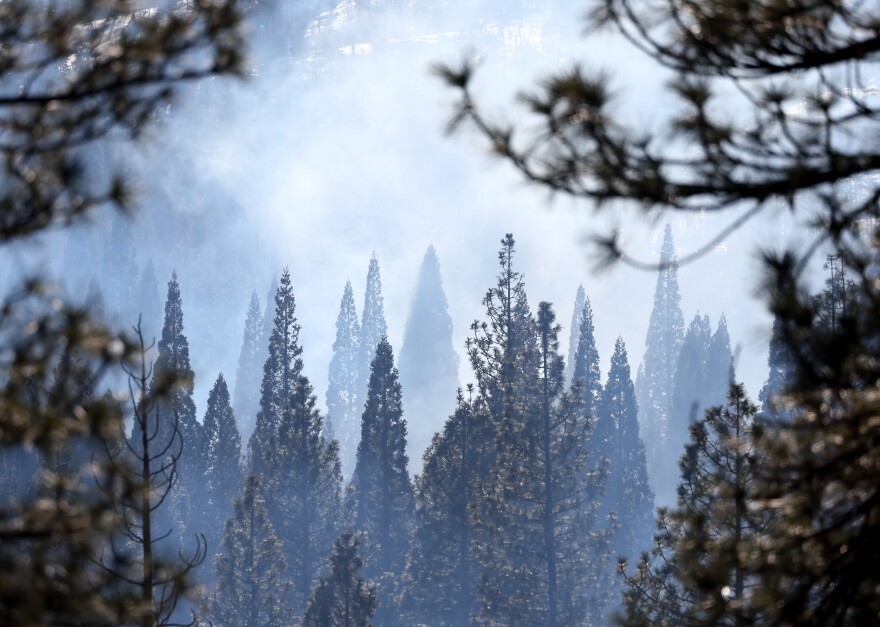With our free press under threat and federal funding for public media gone, your support matters more than ever. Help keep the LAist newsroom strong, become a monthly member or increase your support today during our fall member drive.
Climate is changing too quickly for the Sierra Nevada's 'zombie forests'

Some of the tall, stately trees that have grown up in California's Sierra Nevada are no longer compatible with the climate they live in, new research has shown.
Hotter, drier conditions driven by climate change in the mountain range have made certain regions once hospitable to conifers — such as sequoia, ponderosa pine and Douglas fir — an environmental mismatch for the cone-bearing trees.
"They were exactly where we expected them to be, kind of along the lower-elevation, warmer and drier edges of the conifer forests in the Sierras," Avery Hill, who worked on the study as a graduate student at Stanford University, told NPR.
Although there are conifers in those areas now, Hill and other researchers suggested that as the trees die out, they'll be replaced with other types of vegetation better suited to the environmental conditions.
The team estimated that about 20% of all Sierra Nevada conifer trees in California are no longer compatible with the climate around them and are in danger of disappearing. They dubbed these trees "zombie forests."
The environment is changing faster than the trees can adapt
The team scrutinized vegetation data dating back to the 1930s, when all Sierra Nevada conifers were growing in appropriate climate conditions. Now, four out of five do.
That change is largely due to higher temperatures and less rainfall in these lower-elevation areas, as well as human activities, such as logging, and an uptick in wildfires.
The Sierra Nevada conifers aren't standing still. The average elevation of the trees has increased over the past 90 years, moving 112 feet upslope. According to Hill, that's because lower-elevation conifers have died while conifers at higher elevations where the air is cooler have been able to grow.
But the conifers' uphill trek hasn't been able to keep pace with the dramatic increase in temperatures.
The researchers said the number of Sierra Nevada conifers incompatible with their environments could double in the next 77 years.
The new maps can inform forest conservation and management plans
But Hill, who is now a postdoctoral researcher at the California Academy of Sciences, hopes that the maps he and his colleagues developed showing the state's "zombie forests" will help shape people's understanding of the effects of climate change.
"Conservationists know, scientists know, so many people know that ecosystems are changing and expect them to change more, and people are grappling with this," he said.
"These maps are unique, in that you can put your finger on a point and say, 'This area right here is expected to transition due to climate change in the near future,' and this forces some really difficult questions about what we want this land managed for and do we try to resist these impending changes," Hill added.
Copyright 2023 NPR. To see more, visit https://www.npr.org. 9(MDA1OTI3MjQ5MDEyODUwMTE2MzM1YzNmZA004))
At LAist, we believe in journalism without censorship and the right of a free press to speak truth to those in power. Our hard-hitting watchdog reporting on local government, climate, and the ongoing housing and homelessness crisis is trustworthy, independent and freely accessible to everyone thanks to the support of readers like you.
But the game has changed: Congress voted to eliminate funding for public media across the country. Here at LAist that means a loss of $1.7 million in our budget every year. We want to assure you that despite growing threats to free press and free speech, LAist will remain a voice you know and trust. Speaking frankly, the amount of reader support we receive will help determine how strong of a newsroom we are going forward to cover the important news in our community.
We’re asking you to stand up for independent reporting that will not be silenced. With more individuals like you supporting this public service, we can continue to provide essential coverage for Southern Californians that you can’t find anywhere else. Become a monthly member today to help sustain this mission.
Thank you for your generous support and belief in the value of independent news.

-
A tort claim obtained by LAist via a public records request alleges the Anaheim procurement department lacks basic contracting procedures and oversight.
-
Flauta, taquito, tacos dorados? Whatever they’re called, they’re golden, crispy and delicious.
-
If California redistricts, the conservative beach town that banned LGBTQ Pride flags on city property would get a gay, progressive Democrat in Congress.
-
Most survivors of January's fires face a massive gap in the money they need to rebuild, and funding to help is moving too slowly or nonexistent.
-
Kevin Lacy has an obsession with documenting California’s forgotten and decaying places.
-
Restaurants share resources in the food hall in West Adams as Los Angeles reckons with increasing restaurant closures.







